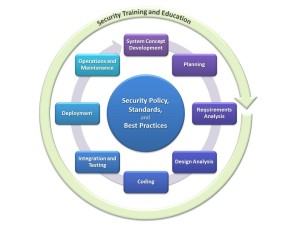Once the main epics of a product release are known, the team can get into a more detailed “what needs to be built” analysis, and even get a first high-level understanding of the “how”.
The majority of the main functional and non-functional requirements can be derived from the product vision. During the requirements analysis, this initial set of requirements becomes more detailed and the architects start adding more comprehensive requirements that are, for instance, derived from best practices. In this step, the Security Architect will start a security requirements analysis to add to the requirements pool for the project. Eventually, this pool will translate into user stories and tasks and be assigned to PSIs (when following an agile development model like SAFe), but we are not quite there yet!
The security requirements analysis usually starts with an analysis of the product’s target market. As an example, if the product is meant to be sold to medical offices in the US or meant to process credit card payments, a lot of mandatory requirements derived from HIPAA and PCI respectively must be implemented by the product, or it cannot be shipped. On the other hand, if the product is mostly used by consumers, there are a lot of best practices that drive requirements for the product, but many of them are not mandatory for the product to be released.
Once the target market has been determined, the Security Architect should reach out once more to product management and marketing to understand if there are specific features that would allow the product to perform better in the market. Commonly, the Security Architect will help marketing and product management to analyze products of competitors, and suggest improvements that would distinguish the product from the competition. Trivial examples include offering encryption or privacy protection where competing products transfer or store data in plain text, implementing strong auditing and giving the customer easy access to such data, and offering secure and innovative authentication mechanisms where competitors only support username / password based authentication.
Security requirements are often derived from laws and regulations which are often far outside the comfort zone and experience of most developers and product architects. Security stakeholders on the customer side are business information security managers and chief information security officers (CIOs) who speak a language of their own, often leading to misinterpretation of the provided non-functional requirements by the product team. A Security Architect performing the security requirements analysis understands both the relevant legal regulations as well as the language used to correctly interpret them, and translates them into a language commonly understood by product development teams to ensure regulatory compliance.
After these preparatory steps have been completed, the Security Architect commonly works with the product architect(s) on a weighted and prioritized requirements list that ties back to the original target market analysis and also shows the inter-requirements dependencies. This requirements list is meant to help product management decide which security feature to implement for a specific release. It is a decision tool that allows product management to understand that if they want to sell the product to a specific market segment, or sell the product in a specific country, the product has to implement specific requirements. Also, the list might have some “non-negotiable” requirements, which must be implemented e.g. to satisfy corporate security policies.
Highlighting requirements inter-dependencies helps with coarse-grained effort estimations. As an example, if requirements X, Y, and Z depend on a complex set of requirements A, B, and C, and X, Y, and Z are required to sell in a specific market, then product management might decide to delay this feature set for a release or two to allow some extra implementation time to implement A, B, and C first, and rather focus e.g. on a different country in the first release.
At the end of the requirements analysis, the product team should have a clear understanding of what needs to be built to address both short-term and long-term security and privacy concerns for the specific target markets, as well as which requirements to implement first, and options of how to implement them so that they can start the product small and grow it long-term, without painting themselves into a corner.

